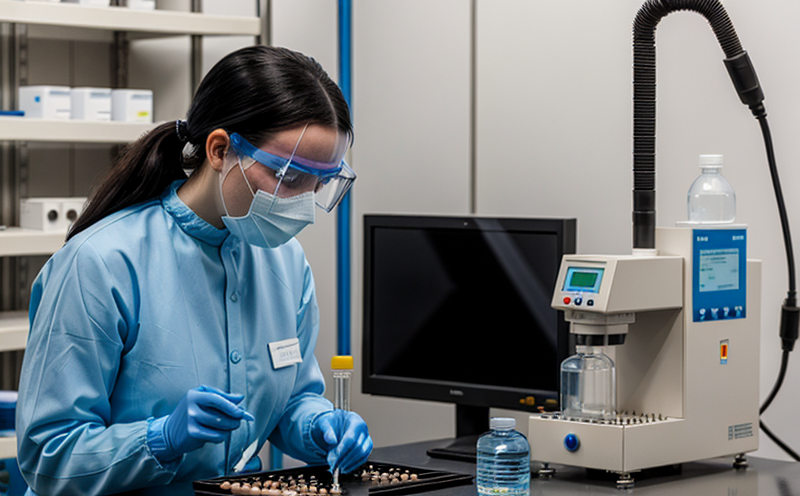ICH Q3A Organic Impurities Testing
The International Conference on Harmonisation (ICH) Guideline Q3A Organic Impurities in New Drug Substances and New Drug Products provides a framework for the identification, quantification, and control of organic impurities in pharmaceutical products. Compliance with this guideline is critical to ensuring drug safety and efficacy, especially during the development stages of new drug substances (NDS) and drug products (NDP).
The ICH Q3A testing protocol aims at minimizing the risk posed by organic impurities that could potentially affect drug quality, stability, or even patient health. By implementing rigorous analytical methods, pharmaceutical manufacturers can ensure that their products meet stringent regulatory standards.
Our comprehensive service offering covers all aspects of ICH Q3A Organic Impurities Testing, from initial sample preparation to final analysis and reporting. Our team employs advanced technologies such as High-Performance Liquid Chromatography (HPLC), Mass Spectrometry (MS), and Nuclear Magnetic Resonance (NMR) spectroscopy to achieve precise and reliable results.
Our approach is tailored specifically for the pharmaceutical industry, ensuring that our clients receive accurate data aligned with ICH Q3A guidelines. This includes detailed documentation of each step in the process, from sample receipt to final report generation. Compliance officers will find this particularly useful as it streamlines their audits and ensures regulatory compliance.
Our state-of-the-art laboratory facilities are equipped with cutting-edge instrumentation that adheres strictly to ICH Q3A requirements. This allows us to provide robust support for quality managers seeking to maintain high standards within their organizations.
The process begins with thorough sample preparation, which involves extracting organic impurities from the drug substance or product using appropriate solvents and techniques. After extraction, the samples undergo various analytical procedures designed to identify and quantify even trace amounts of impurities.
Once identified, these impurities are then subjected to further analysis to determine their structural identity through methods like NMR spectroscopy. This information is crucial for understanding how these compounds interact with the drug molecule itself or other components within the formulation.
For quality managers and R&D engineers looking into this area deeply, our service also offers detailed reports outlining all stages of the testing process, including raw data and interpretations based on ICH Q3A criteria. These comprehensive documents can be invaluable resources when preparing for regulatory submissions or internal audits.
Applied Standards
| Standard | Description |
|---|---|
| ICH Q3A R1 | This revision of the guideline focuses on the identification, quantification, and control of organic impurities in new drug substances and products. It emphasizes the need for thorough risk assessment during development. |
| USP | The United States Pharmacopeia’s chapter 397 provides additional guidance on methods used to detect and measure organic impurities. |
| Pharmacopoeia of the People's Republic of China (ChP) | This Chinese pharmacopoeia includes specific requirements regarding the testing of organic impurities in pharmaceuticals, aligning closely with ICH Q3A principles. |
The application of these standards ensures that our laboratory adheres strictly to internationally recognized practices for identifying and controlling organic impurities. By doing so, we provide clients with confidence that their products meet the highest levels of quality and safety expected by regulators worldwide.
Industry Applications
- Evaluation of drug candidates during early stage development to ensure purity meets regulatory thresholds.
- Supporting batch release testing for compliance with ICH Q3A requirements before product launch.
- Conducting periodic reviews post-market authorization to monitor ongoing impurity levels over time.
- Aiding in formulation optimization by identifying potential sources of unwanted compounds that could affect stability or effectiveness.
- Assisting with regulatory submissions, including providing supporting data for applications seeking approval from various agencies like the FDA, EMA, and WHO.
- Providing evidence-based recommendations to help minimize risks associated with organic impurities throughout product lifecycle management.
These applications demonstrate the versatility of ICH Q3A Organic Impurities Testing across different phases of pharmaceutical development and manufacturing. Our expertise spans these areas, offering tailored solutions that meet individual client needs within the broader context of regulatory compliance.
Environmental and Sustainability Contributions
In addition to supporting compliance with ICH Q3A guidelines, our laboratory also contributes positively towards environmental sustainability efforts. By ensuring that pharmaceutical products contain only necessary organic compounds and no harmful impurities, we help reduce waste generation throughout the manufacturing process.
This proactive approach not only enhances product quality but also supports more efficient resource utilization and reduced emissions associated with production processes. As part of our ongoing commitment to corporate social responsibility (CSR), we regularly review and update our practices to align with evolving sustainability goals.
For organizations focused on green manufacturing and lifecycle management, partnering with us means contributing to broader industry initiatives aimed at reducing environmental impact while maintaining robust quality standards.





